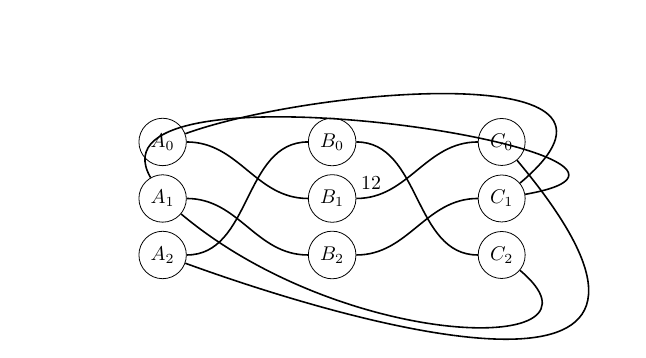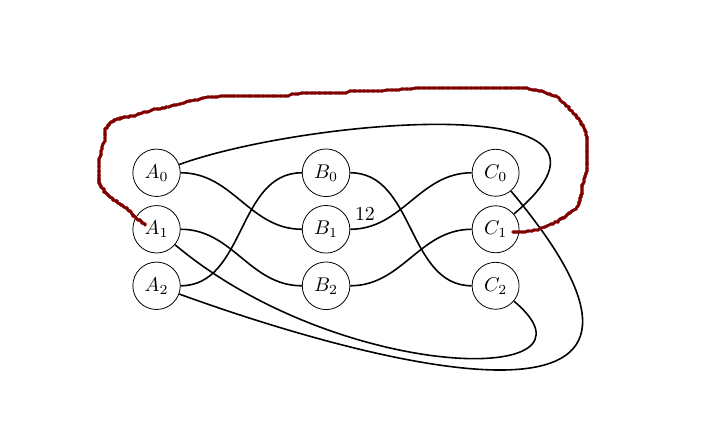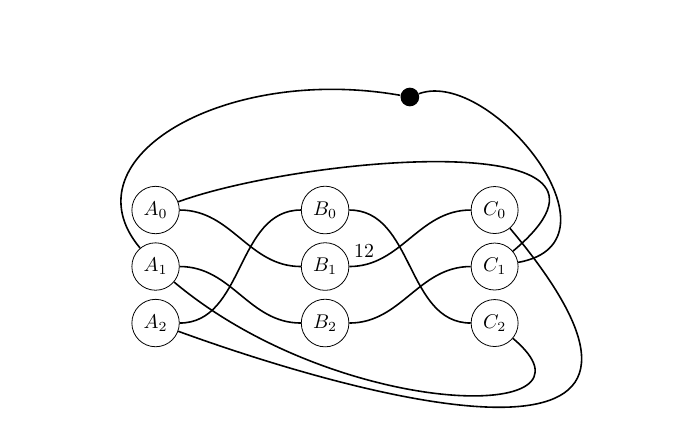## 编译环境
操作系统
Windows 10
Tex发行版
TexLive `2020`
## 我的问题
我正在绘制图论里的图,涉及到一些曲线的绘制。
```
\documentclass...
## 编译环境
操作系统
Windows 10
Tex发行版
TexLive `2020`
## 我的问题
我正在绘制图论里的图,涉及到一些曲线的绘制。
```
\documentclass{article}
\usepackage[utf8]{inputenc}
\usepackage{tikz}
\usetikzlibrary{shapes.geometric, arrows}
\tikzstyle{operator}=[circle, radius= 0.5 cm, text centered, draw=black]
\tikzstyle{operator2}=[circle,fill=black, radius= 0.0 cm]
\tikzstyle{arrow}= [thick, -, >=stealth]
\begin{document}
\begin{tikzpicture}
\node(A0)[operator] {$A_0$};
\node(A1)[operator, below of = A0] {$A_1$};
\node(A2)[operator, below of = A1] {$A_2$};
\node(B0)[operator, right of = A0, xshift=2cm] {$B_0$};
\node(B1)[operator, below of = B0] {$B_1$};
\node(B2)[operator, below of = B1] {$B_2$};
\node(C0)[operator, right of = B0, xshift=2cm] {$C_0$};
\node(C1)[operator, below of = C0] {$C_1$};
\node(C2)[operator, below of = C1] {$C_2$};
\draw (A0) edge[out=0, in=180, arrow] node[pos=0.85, above]{} (B1);
\draw (A1) edge[out=0, in=180, arrow] node[pos=0.85, above]{} (B2);
\draw (A2) edge[out=0, in=180, arrow] node[pos=0.85, above]{} (B0);
\draw (B0) edge[out=0, in=180, arrow] (C2);
\draw (B1) edge[out=0, in=180, arrow] node[pos=0.1, above]{12} (C0);
\draw (B2) edge[out=0, in=180, arrow] node[pos=0.85, above]{} (C1);
\draw (C0) edge[out=-50, in=-20, arrow, out looseness=2.6, in looseness=1.5] node[pos=0.85, below]{} (A2);
\draw (C1) edge[out=40, in=20, arrow, out looseness=1.5] node[pos=0.85, above]{} (A0);
\draw (C2) edge[out=-40, in=-40, arrow, in looseness=1.6] node[pos=0.85, below]{} (A1);
\draw (C1) edge[out=10, in=120, arrow, out looseness=1.5] node[pos=0.85, above]{} (A1);
\end{tikzpicture}
\end{document}
```
得到下面的图

我做了C1A1曲线角度的很多调整,都得不到下面的效果。

于是我添加一个辅助点D0,让我的曲线更容易绘制,可是又涉及到一个问题,就是辅助点不能很好的缩小,即使设置 radius= 0.0 cm 我不希望显示辅助点
```
\documentclass{article}
\usepackage[utf8]{inputenc}
\usepackage{tikz}
\usetikzlibrary{shapes.geometric, arrows}
\tikzstyle{operator}=[circle, radius= 0.5 cm, text centered, draw=black]
\tikzstyle{operator2}=[circle,fill=black, radius= 0.0 cm]
\tikzstyle{arrow}= [thick, -, >=stealth]
\begin{document}
\begin{tikzpicture}
\node(A0)[operator] {$A_0$};
\node(A1)[operator, below of = A0] {$A_1$};
\node(A2)[operator, below of = A1] {$A_2$};
\node(B0)[operator, right of = A0, xshift=2cm] {$B_0$};
\node(B1)[operator, below of = B0] {$B_1$};
\node(B2)[operator, below of = B1] {$B_2$};
\node(C0)[operator, right of = B0, xshift=2cm] {$C_0$};
\node(C1)[operator, below of = C0] {$C_1$};
\node(C2)[operator, below of = C1] {$C_2$};
\node(D0)[operator2, above of = B0,xshift=1.5cm,yshift=1cm]{}; %辅助点
\draw (A0) edge[out=0, in=180, arrow] node[pos=0.85, above]{} (B1);
\draw (A1) edge[out=0, in=180, arrow] node[pos=0.85, above]{} (B2);
\draw (A2) edge[out=0, in=180, arrow] node[pos=0.85, above]{} (B0);
\draw (B0) edge[out=0, in=180, arrow] (C2);
\draw (B1) edge[out=0, in=180, arrow] node[pos=0.1, above]{12} (C0);
\draw (B2) edge[out=0, in=180, arrow] node[pos=0.85, above]{} (C1);
\draw (C0) edge[out=-50, in=-20, arrow, out looseness=2.6, in looseness=1.5] node[pos=0.85, below]{} (A2);
\draw (C1) edge[out=40, in=20, arrow, out looseness=1.5] node[pos=0.85, above]{} (A0);
\draw (C2) edge[out=-40, in=-40, arrow, in looseness=1.6] node[pos=0.85, below]{} (A1);
%C1到A0借助辅助点D0
\draw (C1) edge[out=10, in=20, arrow, out looseness=1.5] node[pos=0.85, above]{} (D0);%
\draw (D0) edge[out=170, in=130, arrow, out looseness=1.5] node[pos=0.85, above]{} (A1);
\end{tikzpicture}
\end{document}
```

我应该怎么得到我想要的 C1A1曲线。谢谢大家!
一周热门 更多>